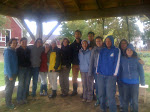 |
| Safer in our bright orange |
Our morning session had us in the woods with Forester Jody, teaching us the elements of "managing a woodlot." As he proceeded to coach us in the choosing of saving and of harvesting trees, it seems that the managing of a wood lot is as much an art as it is a science. Note that we are wearing bright colors as it is the first of two weeks of deer hunting season here in Massachusetts. Ok, back to the work. We are managing this woodlot for cordwood, for lumber, for plant diversity, for animal habitat, for recreation and for plain ol' beauty. A tall order but doable.
 |
| Jody pointing out crown features |
As we choose trees, we also considered the path through which we would skid the logs with the oxen or the horses with the help of Bradley from Sentinel Elm farm. Jody talked to us about the different varieties of trees, the signs of tree health and disease, spacing between the crowns of tree and the different uses for trees. We also had an extensive discussion on the history deforestation of Connecticut and Massachusetts during the late 1700's and 1800's--how coal was made from smoldering piles of trees and mixed with iron and lime to make pig iron. Between the iron industry and agriculture, New England was nearly treeless. Ever since then, trees have been growing back and foresters have been learning how trees return to a cleared area and how to maintain a healthy forest.
We choose trees to save and then looked around to see what had to go. We blazed the trees with an axe hack on two sides at eye-ball height. Jody told us how to figure out cordwood. Ten trees which measure between 6 to 12 inches at breast height ought to make a cord. He had an amazing "ruler" of sorts that measured width, measured height of the tree and a few other details. Hopefully one of my classmates can add detail about this
 |
| Emma blazing red maple tree |
 |
| Kiyoski marking an oak tree |
 |
| Brian marking a black birch |
 |
| Ash bark |
 |
| Elm bark |
During our class, a turkey flew up into a tree nearby and watched us for a good long while. Can you imagine a barn-yard gobbler flying up to a branch 30 feet overhead? Well, this beautiful bird did and we all checked and revised our stereotype of the bird.
To wind up our time with Jody, we observed and discussed the trees along the hedgerow. Allow for shade for the animal pasture, no shade for the crop field, keep black cherry out of the hedgerow (as a half-wilted leaves have a cyanide compound that can kill a cow), and include maple but fence the animals away as they love to chew on the bark and could girdle and kill the tree. Again, the information was rapid fire and I'm not sure I have it all. The main idea is that the trees in hedgerows are to be managed as well.
 |
| Sorting meat into CSA bags |
Our afternoon was spent with Olivier undertaking two important tasks. Our first task was to package up the Meat CSA. "CSA" stands for Community Sponsored Agriculture and it involves people paying upfront for a share of the meat produced on Maggie's Farm. We promise them 12 pounds of meat a month for six months. Then at the beginning of each month--from October to March, we deliver grass-fed beef, pork and lamb in frozen packages. It was fun (and cold) to sort the meat into the bags, trying to make sure each bag received a variety of cuts and trying to come close to (and a tad over) the 12 pound mark. Once the bags were sorted and weighed, we put them back in the freezer for delivery to the Boston area. We also put a box of pig hearts, liver and lard in our freezer for fun and interesting recipes to yet be determined. As we sorted the meat, we grilled Olivier (not literally...) on the thinking and planning that goes into a successful Meat CSA--how to plan, what glitches can happened and more. Our jaws dropped when we learned that one can insure their animals as well as insure the meat that comes from them. So much to learn.
Our last task of the day was to move the cows to Janet's pasture. If you've been looking closely at the photos, you might recognize a shift in group members. Nora, Brian and I were moved into Group A with Sophia, Kiyoshi and Emma. We ex-B-teamers were happy to show the A Team how to move cows--Brian parked the truck in the middle of the road, I handed out fence posts and Nora coached them in calling "Come On Girls" across the road. All transpired without a hitch... Emma and I brought the manger down into the new field and took turns being "the hamster" inside. Kiyoshi may have taken a video of it--see their blog: http://muckinaround.tumblr.com/
We also enjoyed feeding the cows in their new field. A good day for a new Team A. And just WHAT is that blurry, color splodge there? Hmmm, we'll have to ask Linnea...


















































